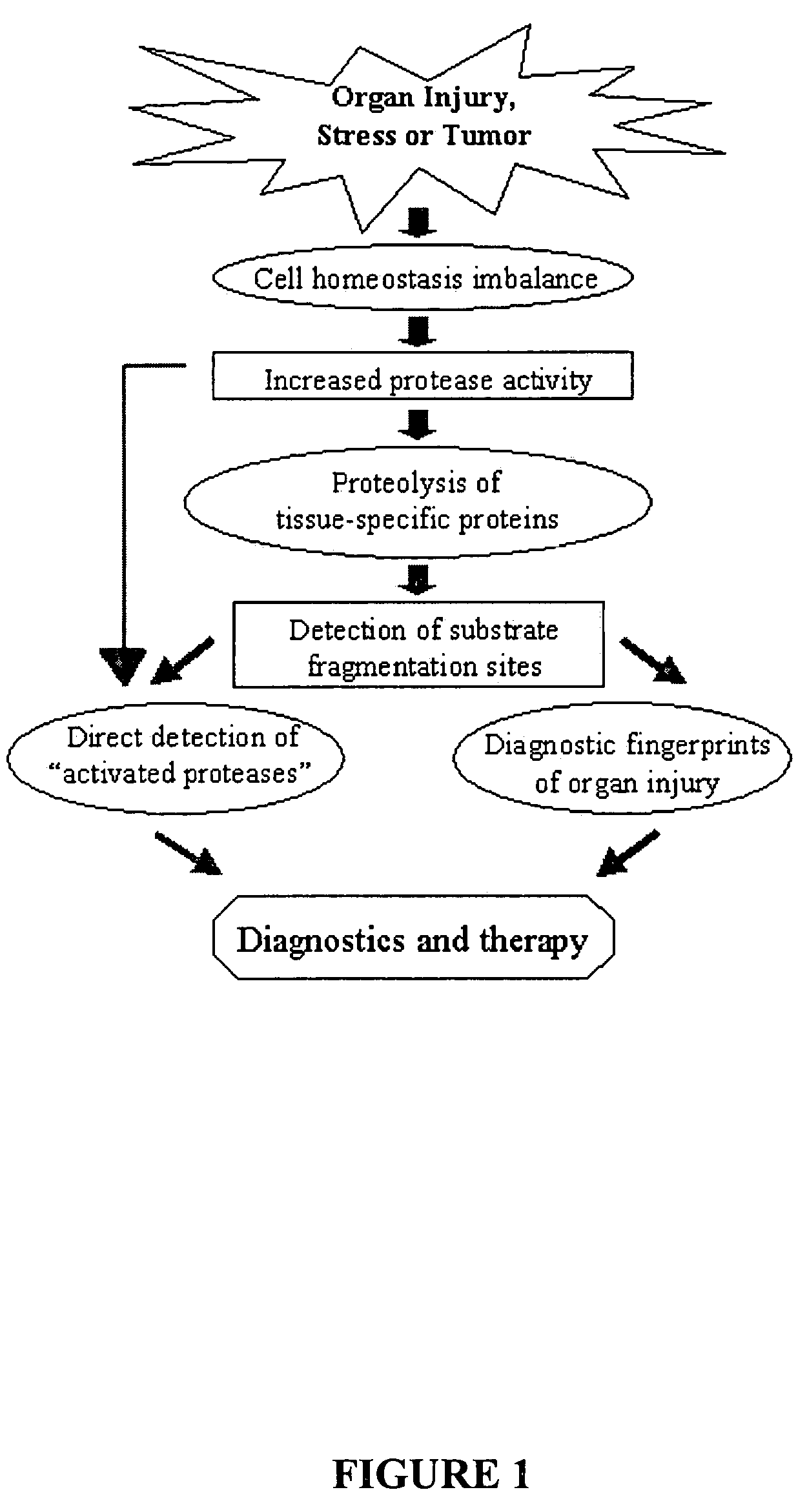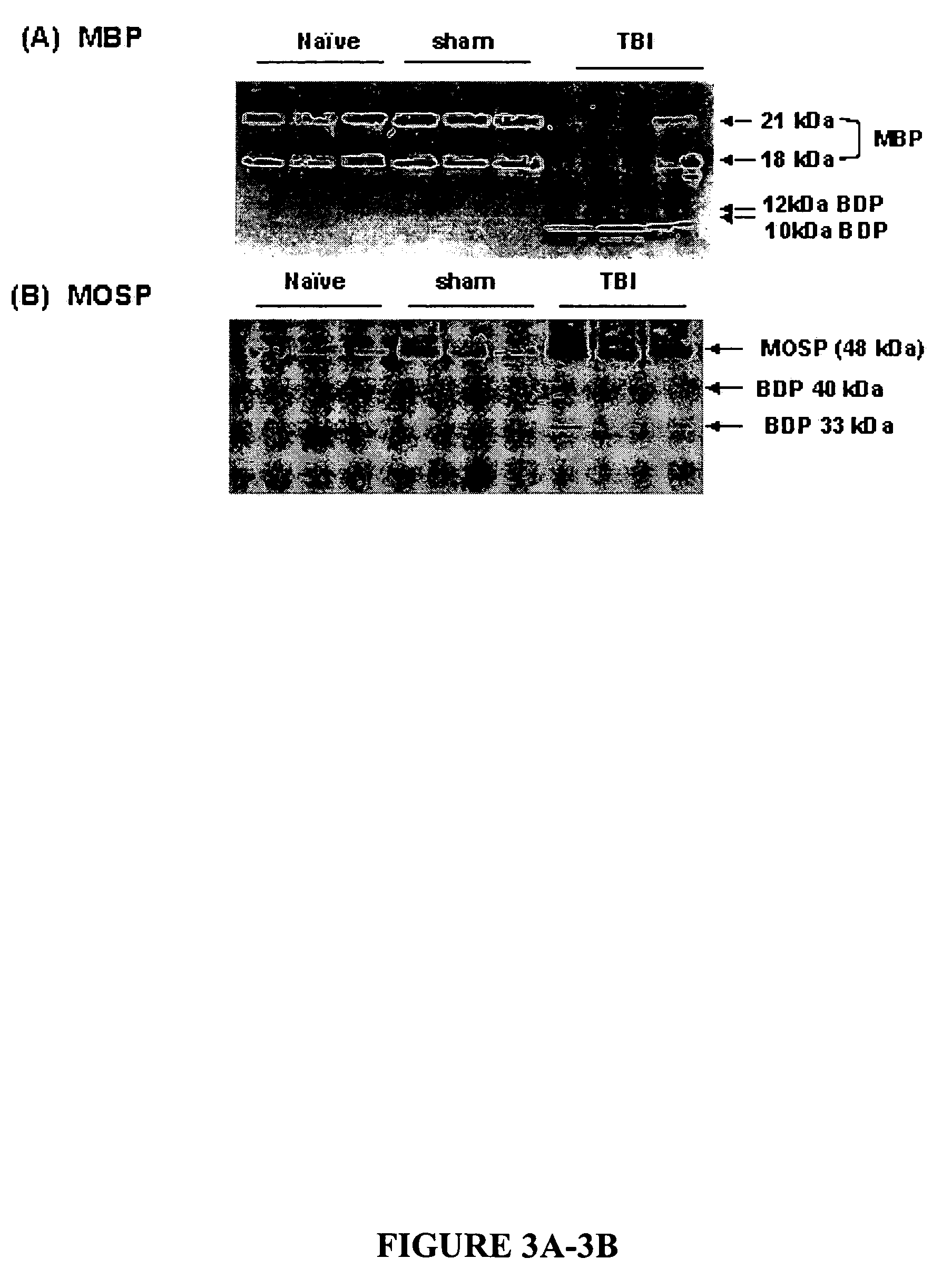Proteolytic biomarkers for traumatic injury to the nervous system
a traumatic injury and biomarker technology, applied in the field of traumatic injury to the nervous system, can solve the problems of inability to quickly be employed in an emergency room environment, high cost of ct and mri, and the majority of tbi survivors are severely affected, etc., and achieve the effect of reliable detection
- Summary
- Abstract
- Description
- Claims
- Application Information
AI Technical Summary
Benefits of technology
Problems solved by technology
Method used
Image
Examples
example 1
Detection of Neural Proteins Subjected to Proteolytic Attack 48 h after Traumatic Brain Injury (TBI) in Rats
[0290]TBI was induced in rodents as described above. 48 h following TBI or sham operation or naïve rats, samples of CSF were collected and analyzed for presence of five novel neural protein markers (MBP and MOSP) (FIG. 3) were identified to be vulnerable to endogenous proteolytic attack, producing major breakdown products (BDPs) in the ipsilateral hippocampus. Ipsilateral cortical samples were also analyzed and they showed very similar patterns of proteolysis. Based on the unique cleavage site in MBP (DENPVVHFF114K115NIVTPP) SEQ ID NO: 184), we have produced polyclonal and monoclonal that specifically detects the new N-terminal (NH2-KNIVTPP) (SEQ ID NO: 149) of MBP-BDP of 12 kDa and 10 kDa (FIG. 4). These unique BDP's when accumulated in biofluids such as CSF and blood are excellent diagnostic markers for organ-specific (brain, spinal cord or peripheral nerve) injury or stress...
example 2
Detection of Myelin Proteins Subjected to Proteolytic Attack 48 h after Traumatic Brain Injury (TBI) in Rats
[0291]TBI was induced in rodents as described above. 48 h following TBI or sham operation of on naïve rats, samples of CSF were collected and analyzed for presence of two novel myelin sheath protein markers; (MBP and MOSP) (FIG. 3) were identified to be vulnerable to endogenous proteolytic attack, producing major breakdown products (BDPs) in the ipsilateral hippocampus. Ipsilateral cortical samples were also analyzed and they showed very similar patterns of proteolysis. Based on the unique cleavage site in MBP (DENPVVHFF114^K115NIVTPP), (SEQ ID NO: 148) we have produced polyclonal and monoclonal antibodies that specifically detect the new N-terminal (NH2-KNIVTPP), SEQ ID NO: 149) of MBP-BDP of 12 kDa and 10 kDa (FIG. 4). These unique BDP's when accumulated in biofluids such as CSF and blood are excellent diagnostic markers for organ-specific (brain, spinal cord or peripheral n...
example 3
Detection of Synaptic Proteins (Synaptotagmin and Synaptojanin-1) are being Degraded in Rat Cortex and / or Hippocampus 48 hr after TBI in Rats
[0292]TBI was induced in rodents as described above. 48 h following TBI or sham operation on naïve rats, samples of CSF were collected and analyzed for presence of five novel synaptic protein markers; Synaptotagmin (top), and Synaptojanin-1 (bottom) (FIG. 5) were identified to be vulnerable to endogenous proteolytic attack, producing major breakdown products (BDPs) in the ipsilateral hippocampus. Ipsilateral cortical samples were also analyzed and they showed very similar patterns of proteolysis. These unique BDP's when accumulated in biofluids such as CSF and blood, can be detected by immunological techniques such as Western blots or ELISA and thus are excellent diagnostic marker for organ-specific (brain or spinal cord or peripheral nerve) injury or stress (FIG. 1).
PUM
| Property | Measurement | Unit |
|---|---|---|
| temperatures | aaaaa | aaaaa |
| temperatures | aaaaa | aaaaa |
| temperatures | aaaaa | aaaaa |
Abstract
Description
Claims
Application Information
 Login to View More
Login to View More - R&D
- Intellectual Property
- Life Sciences
- Materials
- Tech Scout
- Unparalleled Data Quality
- Higher Quality Content
- 60% Fewer Hallucinations
Browse by: Latest US Patents, China's latest patents, Technical Efficacy Thesaurus, Application Domain, Technology Topic, Popular Technical Reports.
© 2025 PatSnap. All rights reserved.Legal|Privacy policy|Modern Slavery Act Transparency Statement|Sitemap|About US| Contact US: help@patsnap.com



